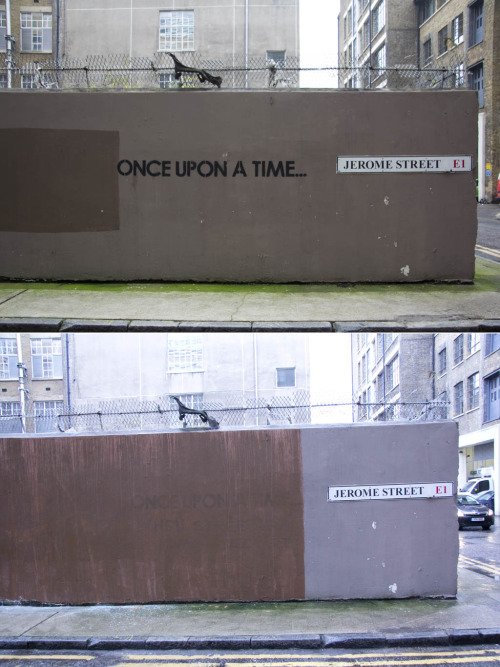
Zambia

Thailand
Just try to look through this series without cracking a smile. Gabriele Galimberti traveled for 18 months gathering portraits of children with their favorite toys.
Adorable Portraits of Kids With Their Favorite Toys
via 22 Words


Just try to look through this series without cracking a smile. Gabriele Galimberti traveled for 18 months gathering portraits of children with their favorite toys.
Adorable Portraits of Kids With Their Favorite Toys
via 22 Words
 Wem gehört das Gebäude, in dem die größte schwule Sauna in Europa sitzt? Selbstverständlich: Dem Vatikan. Und zufälligerweise wohnen im selben Haus nicht nur Kurienkardinal Ivan Dias, sondern ganze 18 weitere Priester des Vatikans. Ich schätze mal, die Jungs können ein paar Sachen über den schwulen Geheimclub in der katholischen Kirche erzählen.
Wem gehört das Gebäude, in dem die größte schwule Sauna in Europa sitzt? Selbstverständlich: Dem Vatikan. Und zufälligerweise wohnen im selben Haus nicht nur Kurienkardinal Ivan Dias, sondern ganze 18 weitere Priester des Vatikans. Ich schätze mal, die Jungs können ein paar Sachen über den schwulen Geheimclub in der katholischen Kirche erzählen.
A day ahead of the papal conclave, faces at the scandal-struck Vatican were even redder than usual after it emerged that the Holy See had purchased a €23 million (£21 million) share of a Rome apartment block that houses Europe’s biggest gay sauna. […]
76-year-old “prince of the church” [Cardinal Ivan Dias, the head of the Congregation for Evangelisation of Peoples,] enjoys a 12-room apartment on the first-floor of the imposing palazzo, at 2 Via Carducci, just yards from the ground floor entrance to the steamy flesh pot. There are 18 other Vatican apartments in the block, many of which house priests. […]
The sauna’s website promotes one of its special “bear nights”, with a video in which a rotund, hairy man strips down before changing into a priest’s outfit. It says Bruno, “a hairy, overweight pastor of souls, is free to the music of his clergyman, remaining in a thong, because he wants to expose body and soul”.
As cardinals gather to elect Pope, Catholic officials break into a sweat over news that priests share €23m building with huge gay sauna (via Arbroath)
Bonustrack: Fantasypope.com: „FantasyPope is a prediction market that taps into the wisdom of the crowds to forecast who will be the next Pope. By ranking the top five candidates, FantasyPope will track in real time the movements and trends during the conclave.“

Boom Art verkaufen zwei Skate Decks mit Wally Wood-Print (via AnimalNY) in einer schicken Holzbox. Und zwar nicht irgendein Print, sondern seine Disney-Orgie aus dem 60er Underground-Mag The Realist, die Ausgabe kann man komplett hier online lesen (Vorher auf Nerdcore: The Realist: Underground Satire-Mag aus den 60s online!)
 Die Background-Story von Paul Krassner (auf dessen Website man einen Print der Orgie kaufen kann, den gibt’s kostenlos zu den Decks, glaube ich), dem Verleger von The Realist, auf dem Blog von Boom Art hat alles, was so ‘ne richtige Disney-Orgie braucht: Magic Mushrooms, fickende Cartoon-Charaktere und eine strippende Tinker Bell. Toll, alles!
Die Background-Story von Paul Krassner (auf dessen Website man einen Print der Orgie kaufen kann, den gibt’s kostenlos zu den Decks, glaube ich), dem Verleger von The Realist, auf dem Blog von Boom Art hat alles, was so ‘ne richtige Disney-Orgie braucht: Magic Mushrooms, fickende Cartoon-Charaktere und eine strippende Tinker Bell. Toll, alles!
Disney had been [Mickey, Donald Duck, Goofys] Intelligent Designer, and he had repressed all their baser instincts, but since he had departed they could finally shed their cumulative inhibitions and participate together in an unspeakable Roman binge, to signify the crumbling of an empire. I assigned Mad magazine artist Wally Wood to create — as a black-and-white center-spread for The Realist which then became a popular poster – the infamous Disneyland Memorial Orgy.
Pluto is pissing on a portrait of Mickey Mouse, while the real, bedraggled Mickey is shooting up heroin with a hypodermic needle. His nephews are jerking off as they watch a combination bed and cash register where Minnie Mouse is fucking Goofy. The beams shining out from the Magic Castle are actually dollar signs. Dumbo the elephant is simultaneously flying and shitting on an infuriated Donald Duck. Huey, Dewey and Louie are ogling Daisy Duck’s asshole as she watches the Seven Dwarves groping Snow White. The Prince is snatching a peek at Cinderella’s snatch while trying a glass slipper on her foot. The Three Little Pigs are humping each other in a daisy chain. Jiminy Cricket is leering as Tinker Bell does a striptease and Pinocchio’s nose gets longer and longer.
Nach dem Klick noch Scans der Orgien-Illu in einer Backlight-Variante und das S/W-Original aus The Realist, alles in HighRes:


Roboticists at Brown University are one step closer to the dream of a building a robotic bat, and it’s an important step — they’ve developed a robotic bat wing, without which a robotic bat would be nothing more than a robotic mouse, which I think we can all agree would be pretty boring. I mean, sure, right now, the wing is mostly only good for learning more about the aerodynamics of bat wings and demonstrating how bat flight works. But why would you want to know that unless you’re planning, at come point down the line, to build a robotic bat? There’s no good reason to have that information otherwise! Learn how — and why — one builds a bat wing and get a look at how it compares to the real thing in the video below.
While the wing isn’t identical to the natural wing of the lesser dog faced bat on which it is based, it is close enough to provide valuable points of reference on how bats fly, and as a robot rather than a live bat, it’s much easier for researchers to work with, as it is not constantly terrified and confused, like we imagine a real lab bat would be — and not without cause. The Brown team published a paper describing the robotic wing and offering the details of preliminary tests on it appeared this week in the journal Bioinspiration and Biomimetics.
(via Brown University)
Relevant to your interests
A team of European penguin researchers found some unexpected results when they turned infrared heat sensing cameras on a group of emperor penguins they were studying. The outer layer of the birds feathers, they found, was actually colder than the surrounding air. While it goes against common sense, keeping their outermost layers ice-cold may actually help penguins stay warm deeper inside — where it counts.
Researchers from the Universite de Strasbourg in France and other institutions snapped thermal pictures of hundreds of penguins who had left the protection of the giant huddles that keep them warm, presumably because they found themselves seated next to someone who wouldn’t shut up about their startup. When they abandoned the huddles, researchers were surprised to find the penguins temperature dropped to below that of the surrounding air — which, when you’re in Antarctica, is already very, very low indeed.
The outer layers of the penguins feathers generally registered four to six degress Celsius lower than the air around them. Since their outer layer is colder than the air around them courtesy of what researchers described as “extreme radiative cooling,” the birds can actually draw a little bit of warmth from the sub-zero environment. It’s not much warmth, say researchers, and much of it is probably lost when it passes through the skin, which is not a great conductor of heat. When you’re a penguin, though, every little bit of heat counts.
The team also found that some parts of the penguin’s body did manage to remain warm. That includes their eyes, which are surrounded by specialized rings of blood vessels that keep them warm — and result in the bird’s eyes glowing bright red in infrared photos, making it look like some strange, squat, Technicolor demon.
(via Biology Letters, image courtesy of Universite de Strasbourg)
Relevant to your interests
Man, 3D printing keeps getting more and more popular! The tech keeps getting better, so it makes sense that its popularity should rise as well. Soon everyone will have their very own 3D printer. You’ll be able to 3D print your friends, your pet, maybe even yourself! But until that day, let’s consider MakerBot’s new Digitizer Desktop 3D Scanner, which lets you duplicate a dirty garden gnome, or at least whatever fits inside its scanning frame.
MakerBot’s founder, Bre Pettis, unveiled the prototype at SXSW Interactive yesterday and explained the basic technology. Using lasers and cameras — what else? — the Digitizer creates a digital file out of any physical object you want, so long as it’s no larger than 8-by-8 inches. (EDIT: Probably another eight on there too, assuming it’s a cube. Thanks, bartj!) Then it prints the object using a MakerBot replicator and it does so in less than three minutes. Pettis also highlighted the real gimmick here: You don’t need any design experience or knowledge of 3D modeling. Which makes me wonder why this isn’t an Apple product. I think maybe you just need a pulse, which is great news.
To put this in terms that are easy to digest, Pettis said:
“This is kind of like what happened when Flynn (in Tron) gets digitized into the game grid. This takes us from being a 3D printer company into being a company that’s building out a 3D ecosystem.”
Like all innovative tech, the question is, what bigger things will come of this? Pettis addressed that, sort of. “Our biggest customer is NASA,” he said, “Which just makes the nerd in me so happy. They can make cheap prototypes on our machines before using their high end one.”
So until MakerBot makes larger Digitizer Desktop 3D Scanners, we’ll just need to content ourselves with objects smaller than 8-by-8. Which is fine. We can work with that. Let’s see, what’s something I already have but could sure use more of?
Oh, right.

I wonder if I can engineer my DM-only d20s to display only 20s on their faces.
(MakerBot via The Verge, images courtesy of MakerBot)
Relevant to your interests








“The Art Toast Project Presents:” by Ida Skivenes
Idafrosk.com // Instagram: @Idafrosk

Über Jan Bannings – Anarchist, Soziologe und Fotograf – brillante Fotoserie Bureaucratics habe ich schonmal vor vier Jahren gebloggt, die geht aber grade mal wieder rum und ich finde die immer noch superfantastisch, also was solls. Banning hat von 2003 bis 2008 Bürokraten auf der ganzen Welt abgelichtet, dazu ist er einfach unangemeldet auf’s Amt gelatscht und hat geknippst. Heraus kam eine soziologische Studie von einem Anarchisten über den Typus Bürokrat. Ganz, ganz groß!




Bureaucratics is a project consisting of a book and exhibition containing 50 photographs, the product of an anarchist’s heart, a historian’s mind and an artist’s eye. It is a comparative photographic study of the culture, rituals and symbols of state civil administrations and its servants in eight countries on five continents, selected on the basis of polical, historical and cultural considerations: Bolivia, China, France, India, Liberia, Russia, the United States, and Yemen.
In each country, I visited up to hundreds of offices of members of the executive in different services and at different levels. The visits were unannounced and the accompanying writer, Will Tinnemans, by interviewing kept the employees from tidying up or clearing the office. That way, the photos show what a local citizen would be confronted with when entering.
Bureaucratics (via Laughing Squid)
Even as the Curiosity rover roves across the rusty-hued surface of Mars collecting samples, multimillionaire “space tourist” Dennis Tito announced earlier this week that he plans to send his own mission to the Red Planet in five years. Except Tito’s intent on sending humans, not robots. That’s a formidable trip to make, fraught with the perils of time, atrophy, boredom, and high-energy radiation from the depths of space! To protect against such cosmic rays, Tito’s team says they will use the astronauts’s own fecal matter as part of their wall shielding.
Two leading things to keep in mind: (1) Cosmic rays, which come from deep space, are deadly and constant. Even if you shield against them, what remains can still be harmful, and (2) Tito’s mission isn’t meant to be an exploratory quest of flag-planting and rock-gathering on Mars, just a two-person fly-over inside a small, cramped vessel (which hasn’t been built yet). Even so, the dangers are real.
Not since Kevin Costner’s pee-drinking scene in Waterworld have we seen such a practical use of recycled waste. To be fair, they’re not suggesting that only poo be used, because gross. No, food and water would also be layered up on the walls of the ship to construct whatever shielding they can. It’s simply a pragmatic application of the law of the conservation of matter, because space aboard a vessel like the one they’re going to need is hard to come by, and you’ve got to hold onto and use everything you’ve got.
A member of Tito’s team, Taber MacCallum told the New Scientist:
It’s a little queasy sounding, but there’s no place for that material to go, and it makes great radiation shielding. …Dehydrate [it] as much as possible, because we need to get the water back. Those solid waste products get put into a bag, put right back against the wall.
This utilitarian — or poo-shielding — plan is part of the team’s Water Walls project, “which combines life-support and waste-processing systems with radiation shielding.” Initially the walls of the spacecraft would be lined with special, polyethylene bags filled with drinking water, because water molecules contain more nuclei per volume than metal, which in turn means more protection against the aforementioned cosmic rays. (Which, by the way, can seriously diminish your lifespan.) Gradually, as the water is drawn out for drinking, it’s replaced with waste.
Survival logistics aside, there’s still the matter of whether Dennis Tito’s ambitious, not-sanctified-by-NASA mission will get off the ground. There are plenty of skeptics and believers in the 72-year-old’s dream. Mars and Earth come into alignment once every 15 years, and Tito’s mission is calculated as taking 501 days, and is set to launch on January of 2018.
(New Scientist, images courtesy of J.Gabás Esteban and OnceAndFutureLaura)
Relevant to your interests
“Dole Queen Owns Horse!” screeched the front page of yesterday's Sun. This masterpiece of balanced headlining ran alongside a full-length picture of a distressed-looking pregnant woman who is due to be relocated into an extravagant new home at the government’s expense. The thirty-one year old, who has never held a full-time job, will shortly be moving into a twenty-bedroom palace with a fleet of staff, all funded by the taxpayer at a cost of hundreds of thousands of pounds per year. Kensington Palace, to be precise. The state is to fund the redecoration of every room to suit the unemployed mother-to-be and her husband, who is also out of work after a brief stint in the army.
By now, the twisted logic of tabloid mob-whippery dictates that a small host of outraged citizens carrying pitchforks, cameras and branding-irons should be forming to descend on Kensington. The public must be demanding to know who this brazen madam thinks she is and why she's being allowed to have a kid on the state and hundreds of millions of pounds in handouts instead of accepting a slow slide into alienated penury like the rest of us. Throw the hussy to the vultures! Smear her face over every front-page, have her chased from her home by packs of wild paparazzi! Confiscate her uterus! Rent out the offending organ to wealthy Chinese families until the surrogacy fees have paid back the exorbitant cost of her outrageous hyperfecundity to the public purse! If we’re not careful, every scrounging harlot this side of Anglesey will grow up thinking that the recipe for an easy life is to amass a collection of elegant wrap-dresses and marry the hereditary heir to the Duchy of Cornwall. The shame of it.
Rather than string this one out until it snaps, let's be absolutely clear that we're talking about the Duchess of Cambridge here. By an unhappy oversight of tabloid subediting, Kate Middleton’s picture appeared yesterday in every paper looking slightly sad about some slightly mean things said about her by a Booker Prize-winning author, alongside headlines attacking Heather Frost, mother-of-eleven, for daring to be rehoused by a local council that has a statutory duty to do so. That these two stories have hit the front pages this week tells you most of what you need to know about class and media manipulation in Britain today.
Tabloid persecution of individuals in receipt of welfare benefits is practically encouraged by the Department for Work and Pensions, which has been known to feed its tame papers stories about "benefit scroungers" to drum up support for its policy of plunging hundreds of thousands of children into poverty. Say anything the least bit critical about the Duchess of Cambridge, however, and you’ll get an official reprimand from the PM, or worse. If Hilary Mantel’s subtle and incisive essay merits public excoriation of this sort, I’m expecting a team of black-baggers to burst through my window at any second once they find my back-catalogue of republican rantery - so please forgive any spelling mistakes. I’m writing this column at speed, in the dark, hiding under the bed.
Before they come to take me away, let's look at the figures. Frost's large family costs the British state some £30,000 a year, as opposed to the £30m paid to the Queen per annum, on top of the Royal family’s land-based income and travel and living expenses. The morality of having a child at state expense is not what I want to discuss here: the key difference between Kate Middleton and Heather Frost is that the Duchess’ future children will never be at risk of poverty, whereas Frost’s are. In fact, in the sixth richest country in the world, over a quarter of children and young people live in poverty. The morality of that uncomfortable little statistic is never questioned, because Frost’s real crime in the ledger of proto-fascist tabloid morality is not the fact that she has a lot of children, but the fact that she is poor. Every millionaire in Britain will be receiving a £42,000 tax cut come April, and none of them are being shamed for it on the front page of the Sun.
There are two types of outrage permitted on of this bitter little island right now: dog-whistle disgust for the extremely poor and spanielish devotion to the aristocracy. If we're going to talk about large, dysfunctional families gaming the system and spoiling democracy for hard-working, law-abiding, ordinary citizens, the discussion should start and finish with the House of Windsor. The royals and their retinue cause more damage to the British psyche than any luckless single-parent family scapegoated by the tabloids, and it's a cost that goes way beyond the financial implications of the Civil List. Yesterday’s headlines, like tomorrow’s and next week’s, tell the people of Britain in terms as stark and brutal as an eviction notice: ask for nothing, doff your cap, and know your place.

Amazon-Seller Solid Gold Bomb verkauft knapp eine halbe Million Shirts per Print-On-Demand. Keins der Shirts existiert wirklich, die werden von einem Algorithmus zusammengesetzt, der populäre Motive automatisch in tausenden Varianten remixt. Und so kam’s, dass in Amazons SolidGoldBomb-Shop ein Rape-Joke-Shirt zu kaufen war. Von Kram wie diesem werden wir noch jede Menge hören.
The algorithm that creates these t-shirts is not complex or powerful. This is how I expect it works.
1) Start a sentence with the words KEEP CALM AND.
2) Pick a word from this long list of verbs. Any word will do. Don’t worry, I’m sure they’re all fine.
3) Finish the sentence with one of the following: OFF, THEM, IT, A LOT or US.
4) Lay these words out in the classic Keep Calm style.
5) Create a mockup jpeg of a t-shirt.
6) Submit the design to Amazon using our boilerplate t-shirt description.
7) Go back to 1 and start again.There are currently 529,493 Solid Gold Bomb clothing items on Amazon. Assuming they survive this and don’t get shitcanned by Amazon I wouldn’t be at all surprised if they top a million in a few months.
It costs nothing to create the design, nothing to submit it to Amazon and nothing for Amazon to host the product. If no-one buys it then the total cost of the experiment is effectively zero. But if the algorithm stumbles upon something special, something that is both unique and funny and actually sells, then everyone makes money.
Dictionary + algorithm + PoD t-shirt printer + lucrative meme = rape t-shirts on Amazon (via Boing Boing)

Tolle Anzeige für einen japanischen Früchtebauern, die zusammen mit einer Tageszeitung aus Shizuoka eine komplette Seite mit Mandarinen nachgebaut haben. Dazu haben sie die Früchte komplett auseinandergenommen, alle Bestandteile verwendet und einzelne Worte aus aus den Saftschläuchen nachgebaut. Ein Mandarinen-Layout. Toll!
Tangerines, satsuma oranges, mandarin oranges, cuties – it seems everyone has their own name for it. And in Japan, the Mikan – everyone’s favorite fruit – is everywhere. So when a local newspaper in Shizuoka decided to run their own ad, they teamed up with Mikabi Mikan, a well-known local producer of the fruit, to take advantage of the concept of being “everywhere.”
Without relying on digital manipulation they meticulously peeled and dissected several mikans, using everything from the skin, pulp and juice to recreate an entire front page newspaper.
Mikan Newspaper | an epic ad for oranges
Bonuslyrics: The Flaming Lips – She don’t use Jelly: „I know who a girl who reminds me of Cher, she’s always changing the color of her hair, she don’t use nothing that you buy at the store, she likes her hair to be real orange – she uses tangerines, tangerines…“
Good news for anyone who really likes thinking up passwords! Nearly ubiquitous note taking app Evernote got hacked. The Evernote team says the information the hackers got was limited to user information like usernames, email addresses, and passwords. Evernote is taking steps to keep this kind of thing from happening in the future, but they’ve also released a few standard tips on keeping your password safe, and making everyone reset their password.
It feels like only yesterday that I started using Evernote after years of having it installed, but instead still relying on the default note apps on my phones. It feels that way because it was yesterday when I started using Evernote. Shortly after making my grocery list, Evernote informed the world of the security breach. Lucky me.
In the blog post announcing the security breach Evernote was quick to point out that no payment information like credit card numbers for Premium members was access, nor was any content stored on their servers compromised. Good. I’d hate for hackers to see that I put Nerds on my grocery list. That’d be embarrassing.
In the blog post the Evernote team calls the move to have all users reset their password “an abundance of caution.” They call their password encryption system “robust” and assure users that they work constantly to improve it. They also give users the following tips for creating a new password.
- Avoid using simple passwords based on dictionary words
- Never use the same password on multiple sites or services
- Never click on ‘reset password’ requests in emails — instead go directly to the service
Pretty standard stuff, but with the rash of high profile hacks lately, they’re tips that seem to bear repeating. If you’re an Evernote user you’ll have to reset your password the next time you log in, regardless of how long you’ve used the service.
(Evernote via Engadget, image via micamica)
Relevant to your interests
Chinese vendors are the place to go if you’re looking for counterfeit merchandise. The nation that practically invented the knockoff Coach bag has raised counterfeiting goods to a sublime art form, going so far as to open entirely fake Apple stores so convincing they fool even their own employees. The latest story of a fake product coming out of China, though, has left us too impressed to offer anything but a slow clap as at least one street vendor there has started selling fake walnuts — walnut shells with the nut taken out and replaced with a less tasty chunk of concrete.
While the fake is pretty well done and ingenious, it’s not the most complicated job in the world. The enterprising walnut salesman simply cracked open some of the nuts, removed the meat, and replaced it with a chunk of cement, sometimes wrapped in paper to deaden the sound of pebbles and rocks rattling around in a walnut shell. Then, the shell gets glued back together and returned to the bins, where it waits it’s turn to disappoint and freak out a customer.
(via SingaporeSeen, image courtesy of Xinhua News Agency)
Relevant to your interests

This is a Bios Urn, a completely biodegradable urn that contains a single tree seed. When planted, the tree seed is nourished by and absorbs the nutrients from the ashes. The urn itself is made from coconut shell and contains compacted peat and cellulose. The ashes are mixed with this, and the seed placed inside. You can even choose which type of tree you’d like to grow!
It may be that the distance between educated amateur and scientific expert has widened since the 19th century, but the religious sensitivities Darwinism inflames seem to have remained fairly consistent.
We live in an era of scientific triumphalism, when leading researchers in any number of fields claim they are supremely qualified to explain not only how the universe works, but also what it means. Metaphysics, they tell us, can now be considered a subset of physics.
Thus it's not surprising that distinguished hackles would be raised when a spirited counter-attack is launched by a well-known philosopher who contends that scientists
a) have conveniently ignored gaping holes in their understanding of how evolution has shaped the world and
b) might learn something from the evangelical Christians who promote Intelligent Design.
The philosopher in question is Thomas Nagel, who years ago attracted more than the usual attention accorded philosophy professors with his essay, "What Is It Like to Be a Bat?" Nagel's new book, Mind and Cosmos, comes with a subtitle that succinctly describes the epistemological chip he's placed on his shoulder, daring scientists to knock it off: Why the Materialist Neo-Darwinian Conception of Nature Is Almost Certainly False.
Nagel's argument is that the mechanics of natural selection can't answer one of the most crucial questions of our existence: how living, reasoning creatures emerged from insensate matter. Although he himself is an atheist, Nagel says he shares the theists' conviction that the appearance of such creatures strongly suggests that the universe has, from the beginning, evolved teleologically, meaning it's moving purposively, toward ever-higher levels of consciousness.
"Each of our lives," he writes, "is a part of the lengthy process of the universe gradually waking up and becoming aware of itself." In the present intellectual climate, Nagel hastens to add, "such a possibility is unlikely to be taken seriously."
He got that right. Mind and Cosmos has been the subject of a number of high-profile takedowns, earning it top honors in the Guardian's list of Most Despised Science Books of 2012. So vitriolic has been the response that, as Jennifer Schuessler pointed out in the New York Times, even a relatively sympathetic review ran under the headline, "Thomas Nagel is Not Crazy."
My purpose here is not to review the Nagel controversy (the Times article includes a generous sampling of links for those interested in such a review), but rather to add some historical context by pointing out the striking parallels between his arguments and those made more than a century ago by one of my heroes, the great Samuel Butler.
Butler is best known as the author of the fantasy novel Erewhon, published in 1872. Erewhon, in turn, is best known for its extended meditation on the possibility that machines might one day attain consciousness and take over human beings.
The central character in Erewhon, unnamed in the original novel but identified in the sequel as Higgs, is a hiker who becomes lost in the mountains and stumbles upon an isolated civilization called Erewhon ("nowhere" spelled backward, sort of). Higgs learns that, five hundred years before his arrival, the citizens of Erewhon were alerted to the danger of technological revolt and banned the use of anything but the most primitive machines. The rationale behind this decision is spelled out in a manifesto called The Book of the Machines, which serves as a vehicle for Butler's musings on the implications of Darwinism.
The basic argument in The Book of the Machines is that technology is just as subject to the laws of evolution as plants and animals. There had to have been a moment in biological history when matter made the leap from inert to alive. Who's to say that at some point machines won't make the same leap? The speed of technological progress suggests they're already half way there.
The playful, almost absurdist tone of the Book of the Machines made it easy to conclude that Butler was making fun of Darwin - The Origin of Species had been published 13 years earlier, and remained hugely controversial. Butler denied it. He told Darwin in a letter that he'd intended only to demonstrate, for purposes of his own amusement and that of others, how easily a scientific concept could be distorted by exaggerated analogy.
Those feelings soon changed. Not long after Erewhon appeared Butler began to see what he considered the dark side of Darwin's theory: it portrayed evolution as a wholly mechanical process that removed any spark of creative vitality from the universe. This was directly counter to the views expressed, supposedly as a joke, in The Book of the Machines, which argued that willful intention can be discerned on far lower rungs of the evolutionary ladder than those occupied by human beings.
"Even a potato in a dark cellar has a certain low cunning about him which serves him in excellent stead," the Book of Machines says.
He knows perfectly well what he wants and how to get it. He sees the light coming from the cellar window and sends his shoots crawling straight thereto; they will crawl along the floor and up the wall and out at the cellar window; if there be a little earth anywhere on the journey he will find it and use it for his own ends.
Thomas Nagel makes the same point in Mind and Cosmos when he contends that "intelligibility" is "latent in the nature of things." The difference is that Nagel means his argument to be taken seriously, whereas Butler, initially at least, did not.
Early in his writing career Butler considered himself a devotee of Darwin; letters he'd written to newspapers defending natural selection were favorably noted by Darwin himself. Apparently, playing with the ideas implicit in Darwin's theory sowed seeds of doubt in Butler's mind that grew into full-fledged dissent. As Butler's biographer, Clara Stillman, put it, "One of the most interesting things about Butler's reaction to Darwinism is the fact that he was already criticizing it subconsciously before he had any conscious quarrel with it."
That quarrel would come to dominate the remainder of Butler's life. A series of books followed in which he relentlessly attacked not only the limitations of Darwinism, but the integrity of Darwin himself. The great man was guilty, Butler believed, of consistently failing to acknowledge the superior contributions to evolutionary theory of his predecessors, among them Buffon, Lamarck, and Erasmus Darwin, all of whom perceived signs of teleology in evolution.
Butler repeatedly argued that Darwinism explained the mechanics of evolution but overlooked its impetus, a point echoed by Nagel. "The appearance of animal consciousness," Nagel writes, "is evidently the result of biological evolution, but this well-supported empirical fact is not yet an explanation--it does not provide understanding, or enable us to see why the result was to be expected or how it came about."
Like Nagel, Butler believed purposefulness imbues all of creation. He was not an avowed atheist, as Nagel is, but he did eschew and dismiss conventional notions of deity in favor of what can be described as a scientifically-informed pantheism. There's no need, he wrote, to posit some "quasi-anthropomorphic being who schemed everything out much as a man would do, but on an infinitely vaster scale." Rather, he said,
The proper inference is that there is a low livingness in every atom of matter...It should not be doubted that wherever there is vibration and motion there is life and memory, and that there is vibration and motion at all times in all things.
Clara Stillman points out how neatly these ideas anticipate quantum physics, as well as the physics-inspired philosophies of Alfred North Whitehead and others.
Nagel does not extend his musings in Mind and Cosmos to technology. Those issues became less a focus for Butler as well, once he began to take his objections to the biological problems in Darwinism seriously. He would, however, continue to use technological analogies. Teleology doesn't suggest that the amoeba knew it was going to evolve into a fish, Butler said, any more than the first person who used a tea kettle necessarily envisioned a steam engine. We get from amoeba to fish, or from tea kettle to steam engine, incrementally. Change is driven by an inclination to adapt at each step along the way. "The manufacture of the tool and the manufacture of the living organ prove therefore to be but two species of the same genus, which, though widely differentiated, have descended as it were from one common filament of desire and inventive faculty."
This is another point Nagel precisely shares. "My guiding conviction," he says, "is that mind is not just an afterthought or an accident or an add-on, but a basic aspect of nature...I believe that the role of consciousness in the survival of organisms is inseparable from intentionality: inseparable from perception, belief, desire, and action, and finally from reason."
Yet another parallel between Nagel and Butler is that both challenged the scientific orthodoxy of their day from positions outside the scientific establishment, and both were considered by members of that establishment unqualified to render an opinion. It may be that the distance between educated amateur and scientific expert has widened since the nineteenth century, but the religious sensitivities Darwinism inflames seem to have remained fairly consistent.
Perhaps the most dramatic shift since Butler wrote has to do with the evolution of technology. If the transhumanists are right, the uprising of the machines is almost upon us. There's still time to ban them, I suppose, although in Erewhon a civil war was necessary to enforce that course of action.
 |
 |
Den.alain“Not in My Name” felt, even at the time, like a slogan of last resort, as if we had already accepted, on some level, that war was going to happen and the most we could do was tut disapprovingly. The terrible thing about protest is that when it remains satisfied with expressing distaste for the status quo, the status quo is quite happy to proceed as planned. Two million people went home that day feeling they’d at least made their objections felt, but it turned out not to be enough. In the end, it was in our name.
Ten years ago this month, millions of people all over the world marched against the war in Iraq – and were ignored. I was one of them. For me, at the age of 16, there were a lot of firsts on 15 February 2003: first truancy, first solo trip to London, first time seeing democracy rudely circumvented.
Tony Blair’s decision to take Britain into the Americans’ war in Iraq was an immediate, material calamity for millions of people in the Middle East. I’m writing here, though, about the effect of that decision on the generation in the west who were children then and are adults now. For us, the sense of betrayal was life-changing. We had thought that millions of people making their voices heard would be enough and we were wrong.
I wasn’t an activist at the time. I was just a schoolgirl overawed by the sheer scale of my own powerlessnesss. The bus to London from the centre of town left early in the morning and I bagged a seat at the back alongside some older students who chatted about the first Gulf war and the international oil lobby. One of them, I remember, was carrying a handmade placard with a picture of a woman’s pubic triangle luxuriously adorned with real, glued-on human hair and the legend “The Only Bush I’d Trust Is My Own”. Upon being asked the obvious question, she indicated the shy, smiling young man beside her and told us: “Armpit hair.”
As London began to materialise out of its dowdy, drawn-out suburbs, we had no conception of the scale of the organisation and planning involved to get two million people on to the streets. When we got off the bus at Embankment, the roadsides were crammed with buses, people surging along the pavement, joining the hundreds pouring into the road, the whistle-sellers and the newspaper hawkers directing us. Under the bridges by the river, the people moved like a flood. I shinned up a set of traffic lights to get a better look. Tens of thousands of banners and placards, most of them churned out of the same Stop the War press and bearing the legends “No” and “Not in My Name”, moving with slow certainty towards Westminster. From above, all of those cardboard squares seemed to tessellate and resolve into a larger picture – No. No. No. No. No.
It was the first time I remember feeling part of something larger than myself. It was only later, after the war and the next six years of progressive assault on civil liberties had broken any faith I or my schoolmates might have had in the Labour Party, that I learned about the endless arguments that went on behind the scenes. At the time I had no idea of the factional squabbling that prevented that march from becoming the powerful people’s movement it might have been. I don’t remember the presence of union members and socialist parties as vividly as I remember the performance artists with their creepy, bloodypaint- spattered masks, the kids strapped on their parents’ backs, the elderly couples with their Thermos flasks and sandwiches wrapped in foil.
It was a very British protest: polite, resentful and passive-aggressive. One got the sense that if Tony Blair had shown up, he’d have been subject to a mass blanking. There was a muted menace to the mood, chants that would flare up and then die down, some of them endearingly altered versions of current chart hits (“Who let the bombs drop? Bush, Bush and Blair!”). Most of all, there were the whistles, shrill and incoherent and frustrated, like 10,000 PE teachers on the move, a notion that still crops up in my nightmares.
What changed in 2003 was that millions of ordinary citizens around the world finally understood that the game was rigged, because only a few weeks after that march the US and its allies went to war anyway. The people had withdrawn their consent, loudly and peacefully and in numbers too big to ignore, and they had been rebuffed with hardly a second thought. Representative democracy had failed to represent.
“Not in My Name” felt, even at the time, like a slogan of last resort, as if we had already accepted, on some level, that war was going to happen and the most we could do was tut disapprovingly. The terrible thing about protest is that when it remains satisfied with expressing distaste for the status quo, the status quo is quite happy to proceed as planned. Two million people went home that day feeling they’d at least made their objections felt, but it turned out not to be enough. In the end, it was in our name.
I have no doubt that, a decade from now, people in their mid-twenties will speak of the student riots of 2010-2011 with the same sad sense of lessons learned. At Millbank, when 4,000 students and schoolchildren smashed up the entrance to the Conservative Party headquarters and held an impromptu rave in the lobby, several young people mentioned the Stop the War march of 2003, how all that passive, peaceful shuffling from one rally point to another had failed to achieve anything concrete.
My generation’s lack of faith in the political process has often been mistaken for apathy. It is only now, with ordinary people across the world putting their energies into movements that bypass mainstream politics, that the betrayal of Bush and Blair’s wars is beginning to be understood. We have known since we were at school that it’s not enough simply to make our voices heard. We have to make sure that we are listened to – and we’re still working out how to do that.
Editor's note: This piece originally stated that Nato went to war in Iraq. The error has been corrected.

Present (for a Giraffe) 2004, Wool, life-size for a giraffe (approx. 3 x 2 m) - MAI YAMASHITA+NAOTO KOBAYASHI via Knithacker
After years of grueling study, management at the Borgata Hotel Casino & Spa in Atlantic City reached the mind-boggling conclusion that gambling in their casino was not easy enough. Always on the lookout for the best interests of their patrons, the hotel has taken an unprecedented step to make it even easier for guests to fork over piles of cash by offering an amenity available nowhere else in the United States — gambling through the TV in your hotel room. Starting later this month, Borgata guests will be able to wager up to $2,500 a day on digital slots and video poker without even leaving the comfort of their beds.
While the move — which makes porn just the second most sinful thing you can order through a hotel room television – may seem like a shameless money grab by the Borgata, it’s actually a quite thoughtful move on their part. Never before in the history of gambling has the transition from losing $2,500 on two hours of video poker to a long, weepy shower in your hotel room, wondering what the hell happened and how you’re going to explain it to your loved ones again been so seamless.
The betting enabled TVs are, of course, also a shameless money grab by the Borgata, which should surprise no one who knows what a casino is. More than that, though, it’s the first of a whole series of increasingly shameless and undignified money grabs that casino management are already gnashing their teeth over. Borgata staff assured the AP that, while TV gambling is a groundbreaking technique for parting people from their paychecks, it’s merely a step down the road toward a brave new world where patrons can gamble using their phones or tablets anywhere on the casino grounds, and maybe even anywhere in the state. Tom Balance, president and chief operating officer of the Borgata, told the AP:
“This puts us in a position to leverage the technology into true mobile gaming and Internet betting later on. We’re moving forward with the future of gaming, and this is that first step.”
Internet gambling, of course, is itself just a step towards an even braver new world in which thousands of retirees simply endorse their Social Security checks over to the Borgata every month in exchange for long-term stays in specially designed Gamblo-Pods that provide shelter, sustenance, and occasionally flash or ring loudly to stimulate the rapidly deteriorating senses of their inhabitants. Truly, the future of gambling is a beautiful place.
The technology, which is already in use on those havens of decency and good decision making, cruise ships, will be installed in all of the Borgata’s 2,000 rooms beginning later this month. Unfortunately, with a February 18 rollout, visitors won’t be able to spend their Valentine’s Days placing bets from bed with the love of their life. You’ll just have to hold on to that dream for next year, Romeo.
(via AP)
Relevant to your interests
Den.alainNon-sexual emotional reliance - really?
How would you define "cheating"? Last December, the editors of an adult toy review blog asked Redditors to find out what kinds of intimacies would be considered cheating to them. The result of that survey is now available in this neat infographic, which breaks down eighteen different sexual and romantic activities based on the genders and age brackets of the respondents. It's no surprise that sexual intercourse was considered cheating across the board, but interestingly enough, many men regarded activities like sexually explicit conversation and slow dancing to be infidelities.
Submitted by: Unknown (via Reddit)
Share on FacebookDen.alainAs I see it, there is only one thing we can do: develop renewable technologies that are substantially cheaper than coal, and give these technologies to the developing countries. China in particular is not a very globally responsible country; it will continue to pursue growth, economic size, and geopolitical power at any cost, and that means using the cheapest energy source available. The only way China will stop using coal is if it becomes un-economical to continue using coal.
Thus, the rich world should focus its efforts and money on developing renewable energy cheaper than coal.


In 2009, scientists noticed some odd stains cropping up in satellite images of Antarctica's Princess Ragnhild Coast. Now, explorers have traveled there -- the first humans to visit the 9,000-odd emperor penguin kingdom.

(International Polar Foundation)
Emperor penguin colonies are not easy to find: Their breeding grounds are remote, icy expanses, that are unobservable at distances greater than just a few kilometers due to the curvature of the Earth.
So scientists who want to monitor how these birds are faring in an unstable environment have had to come up with inventive ways of spotting them. One effective option: Penguin guano stains, as viewed from space.
In 2009, researchers published a paper identifying 10 new penguin colony locations based on satellite images of "faecal staining." "We can't see actual penguins on the satellite maps because the resolution isn't good enough. But during the breeding season the birds stay at a colony for eight months. The ice gets pretty dirty and it's the guano stains that we can see," Peter T. Fretwell, one of the paper's authors, told the Guardian at the time. In addition to the 10 new colonies, they were also able to confirm or revise the locations of 26 previously known colonies as well.

Global Ecology and Biogeography
Now one of those 10 colonies has received its first human visitors: In December, a team of Belgian and Swiss explorers traveled by snowmobile and foot 30 miles from their base on the Derwael Ice Rise, where they are studying ice loss. They arrived at the colony around midnight (still light out in Antarctica at that time of year) and were stunned to find thousands upon thousands of penguins, some 9,000 or 10,000 all told, depending on who's counting.
"It was almost midnight when we succeeded in finding a way down to the ice through crevasses and approached the first of five groups of more than a thousand individuals, three quarters of which were chicks. This was unforgettable moment," Alain Hubert, the expedition's leader, said in a statement.
On NPR, Hubert described that moment to host Neal Conan (worth listening to in full), "After a few minutes, you have those penguins, you know, just comes to say hello and to look at you, because they are the local population. We are not." The guano, Hubert told Conan, doesn't smell -- it's too cold. But, he reports, "I spoke to some scientists that and they told me, if it was a bit warmer, it's really smelly."Pictures from the expedition capture that moment of first contact and more are available on Hubert's website:

International Polar Foundation

International Polar Foundation

International Polar Foundation

International Polar Foundation

International Polar Foundation

International Polar Foundation

International Polar Foundation

International Polar Foundation
 |
 |

Tatsächlich eine der lustigsten Sachen seit einer ganzen Weile im Netz: Florida Man, worlds worst Superhero… Hier ein paar seiner furchtbarsten Abenteuer:
– Drunken Florida Man Leaves His Baby At A Daytona Strip Club Liquor Store
– Florida Man Arrested In Theft Of “Super Sucker” Sex Toy
– Naked Florida Man Runs Through Dunkin’ Donuts
– Florida Man Arrested Again For Butt Injections
– Florida Man On Probation For Sex With A Donkey Named Doodle, Arrested Again
– Florida Man Finds Way To Connect With Cats
– Florida Man Accused Of Using Whizzinator, Flees
@_FloridaMan – Real-life headlines about the world’s worst superhero. (via “>)
Den.alainLove!!! it







The Story by Mobstr